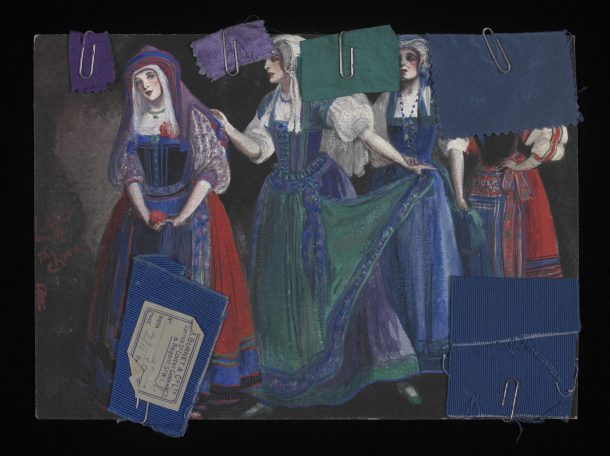Page after page of Bridget D’Oyly Carte’s family archive comes with her felt tip pen annotations in various colours – she arranged it herself, and it hasn’t been rearranged since. Although more time-consuming to use, the scribbles and its idiosyncratic order give the archive a little frisson of authenticity.
Dame Bridget was the last of her family line of hoteliers and theatre producers. Her grandfather Richard D’Oyly Carte built both the Savoy Theatre and adjoining Savoy Hotel in the 1880s. This was the family base on the Strand, from where they also ran the touring D’Oyly Carte Opera Company, Claridge’s and The Berkeley, until Bridget died in 1985. She and her close coterie of staff ran everything from their offices in the labyrinthine Savoy hotel.

S.3301-2015 © Victoria and Albert Museum, London
Richard first made money as the business brains and architect of the Gilbert and Sullivan partnership. It resulted in some of the most memorable comic operas ever produced, and remains one of the most prolific, successful theatrical teams of all time. The related material arrived in batches from Dame Bridget to the now defunct Theatre Museum, then a branch of the Victoria and Albert Museum. It was Sir Roy Strong, director of the V&A at the time, who persuaded Bridget to share them. He was thrilled, as he recorded in his diary:
I took Dame Bridget D’Oyly Carte, a lively and distinguished lady, out to lunch to celebrate the gift of things to the Theatre Museum. She was fascinating on the subject of Harold Wilson who was now a Trustee of the Company and had been asked to their hundredth anniversary at the Savoy Theatre. He loved it, made a speech on stage and now she needed him to help save the Company. So he keeps on ringing her up, much to her embarrassment, denouncing the elitism of Covent Garden as against the populism of Gilbert and Sullivan.
Roy Strong, 18 November 1975
Dame Bridget managed to keep her family opera company, presenting its works of Gilbert and Sullivan, touring until 1982, when she finally admitted defeat in its 108th year in the face of spiralling costs. The archive goes back to the earliest days of the company in the 1870s – and earlier still to include family memorabilia that has ended up there with no other home for them. A medal from the Battle of Waterloo, tortoiseshell combs, postcards, childhood photographs and other sentimental items that would surely be with the family, if there were any members left, are mixed in among documents.
Rupert, who was Richard’s son and Bridget’s father, took over at the turn of the twentieth century. Looking through the same swatches as Rupert gives the sensation of being back at his office at the Savoy. He had strongly held opinions on the smallest details of stagecraft. This extended to fabric for individual costumes, discussed at length with the costumiers. He combed through fashion history books and samples of crêpe-de-chine and taffeta, along with boxes of sample head-dresses, looking for the right new clothes. At work, he tended to be referred to as RDC, and this can be seen on queries that needed checking. Papers are marked ‘RDC approved’ – or not.
After Rupert died in 1948, Bridget worked on sifting through her family’s belongings and documents alongside her day job. She, perhaps jokingly or perhaps not, said that she did not want anyone else to do it in case illegitimate children made an appearance somewhere. I was told by a member of staff that she would be in her suite in the hotel, where she lived during the week, with her lamp and magnifying glass sorting out boxes into the night.
March 1985 marked the centenary of The Mikado, but there was precious little to celebrate by then. Having passed out in Marylebone Station, Bridget was told in hospital that she had advanced lung cancer, and that nothing could be done for her. Her illness was kept private so that it would not impact the Savoy share price. When staff and friends came to visit her, she shooed them away, telling them not to make a fuss. Eventually she was ‘sent home to die’, as she told them. She disposed of personal papers and possessions on a bonfire in the garden of her country house in Buckinghamshire. We are unlikely to know what she burned there altogether, but it makes the archive at Blythe House more precious still.
The Secret Life of the Savoy: and the D’Oyly Carte Family is available from the V&A shop on bookshop.org – where sales support the V&A.



I have had a lifelong interest in the D’Oyly Carte and I have a copy of ‘The Secret Life of the Savoy’ which is a most interesting book and one which I would warmly recommend to anyone interested in the Carte family. I hope to see the D’Oyly Carte archive some day.